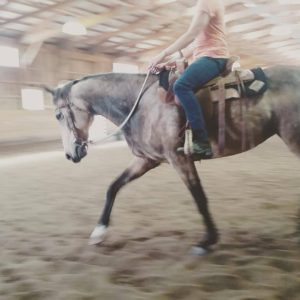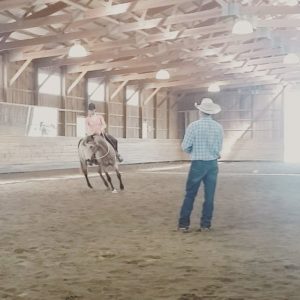Lessons from Sean Patrick
I fulfilled a little dream goal this past weekend and rode in a clinic with Sean Patrick, who wrote Modern Horseman’s Countdown to Broke, the book I used to train my horse! His training style is what I would call logical western, is similar to John Lyons (he did his certification program), but his methods are laid out SO much more clearly in the book than anyone else’s I’ve seen. Talk about task analysis. Anyway, I was pleasantly surprised at how many of his points about training horses can carry over to training therapy horses AND instructing riders. Here are some ideas I have been ruminating on that I want to share with you – in no particular order, my thoughts on therapeutic riding application in italics. As usual, everything’s in my own words so don’t hold Sean accountable if I got it wrong. And as usual, this post is longer than expected. Enjoy!
Rein Aids
When using rein aids, instead of holding your hand firm which the horse can brace against, twiddle the bottom one or two fingers to soften the horse. It’s easy to lean on a wall, but if the wall vibrates, you probably not lean on it so hard – in fact, it’s very difficult to lean on something that is moving or feels like it might drop you.
Therapy horses often pull or brace on the reins. Ask riders to have a more dynamic use of their fingers, playing with the bottom two. Be careful that this doesn’t lead to see-sawing the reins with their whole arms, it’s just the lowest fingers. Have exercise riders do this too, with horses that brace. When the horse becomes light and stops leaning, reward with a loose rein or soft feel.
For Horses That Lean In The Turns
To help:
- Ride a square. Set up 4 cones in half the arena and ride a square around them. Use the inside rein and leg to keep the horse’s shoulder over and up.
- In exercise rider sessions, use this pattern for horses that lean – or maybe just all the horses.
- Put cones in the corners of the arena, for the horse to go around.
- In lessons, put cones in the corners of your lessons and see if it helps.
- In exercise rider sessions, use cones in the corners. My idea is that the horse gets used to going through corners without leaning and it becomes so automatic they do it in lessons regardless of how helpful the leader and/or rider are or or not. Because not leaning will help the horse carry the rider with less stress, and help the rider keep posture and receive the movement of the horse better.
- The rider must think/be upright and not lean.
- This was really highlighted to me by this short Warwick Schiller video a while ago.
- The rider can point their pelvis (belt buckle) to the outside of the turn. Instead of leaning into the outside stirrup, control the seat and pelvis direction.
The Importance Of Patterns
The biggest takeaway for me was The Importance Of Patterns. There is great value in repeating patterns. Like anything, it’s how you use it: there is a different between drilling a horse to death and using repetition as a tool. Remember, horses feel safe when things are familiar and predictable, which allows them to relax and carry their body correctly and therefore carry the rider correctly. So if you have patterns that you work your horse in so much they becomes comfortable and predictable, you can use them to calm the horse when he’s worked up, and to teach the horse new things by adding to existing patterns and going back and forth from the new and old.
Train therapy horses in predictable patterns in exercise rider sessions that can be carried over to use in lessons. Get the horse so good at them in training that when they do it in lessons it becomes easy and calming, and they are more likely to carry themselves correctly even if the rider is not helping them do so.
- Patterns on the ground that the leader can use before, during, or after a lesson to prepare or calm the horse.
- Patterns that can be used to calm a horse down in case of emergencies, such as simple alternating circles.
- Patterns that the horse often does in lessons: circles, figure 8s, serpentines, various turns.
Does this sound familiar, like some of your riders? Familiar patterns and repetitions are comforting to many disabilities.
- Practice simple patterns that your riders know and are comfortable with. Then use them when the rider needs to calm down, such as when something has changed in their lesson, or at a horse show.
- There is value in working on the same patterns week after week, as opposed to always doing something new each week! The rider becomes comfortable with a few key exercises that you can come back to any time; you can track progression better; more progress and refinement can be made over several weeks if you stop switching things up all the time.
Reward The Effort, Not The Accomplishment
“Release on the thought.” Sean stressed that you reward the horse for the thought, not after it. Ex) Ask the horse to back up, and release pressure when he is speeding up (thinking about backing up), not when he is slowing down (thinking about stopping) – or else he’ll slow down to get the whoa.
This can probably be applied to giving feedback to riders as well: give feedback when they are doing it, not after. Some people need to know in the moment when they are doing it right or wrong, as it is harder to connect what they did when discussing it later. Ex) Tell the rider ahead of time, “When you are posting on the correct rhythm, I’ll say ‘good, good, good.'” Instead of later saying, “You posted the middle 3 steps in perfect rhythm!” which may be harder to remember. Ex) Give the rider a reward break when they are trying hard or had the right idea, not necessarily when they accomplished the goal.
Don’t Drill A Skill, Instead Use Tools To Fix The Individual Parts
While repeating simple patterns can be soothing to a horse, drilling a maneuver or picking on the horse too much during the maneuver will sour them. So use tools and teaching aids around the maneuver to fix the individual components and prepare them to out it together correctly later.
Ex) To fix a horse’s short tight canter, do a lot of trotting. Ex) They ask trained reining horses to spin only three times each direction a day, doing an exercise to prepare the horse before it. If the horse is sticky getting into the spin (I can’t remember exactly how in this example), then use exercises before the spin that move the horse away from the inside leg so that when the leg comes off the horse goes right into that opening for the spin. The first time she rides a small circle with inside bend and when it’s good, takes her inside leg off to spin. The second time she leg yields across the arena and does the same thing putting her inside leg on then taking it off to start the spin. The third time she rides a counter bend on a circle, same thing with the outside leg which will be the inside leg of the spin. (Sorry if that’s not too clear, it’s just a quick example.)
Use this technique with riders: Don’t drill a skill, rather use lots of dynamic exercise to work on the individual components they need to do the maneuver later. This is the value of warm up exercises to prepare for the skill later on.
Straightness Is Achieved By Breaking Down Each Part
Straightness in the horse is achieve by breaking down all the parts of the horse (right hip, left hip, right shoulder, left shoulder, nose) so that you can control and move each one separately, THEN putting them all back together to get straightness. Straightness is the gift of both sides of the horse.
Straightness is so important for the therapy horse. It lets them carry the rider with less stress. It gives the rider the best movement and input. In training sessions the horses should be worked on the ground to control their individual body parts, to help leaders achieve straightness in their horses during lessons. Leaders should be trained in how to control the individual body parts to achieve straightness, and how to tell if their horse is going straight or not, during simple maneuvers like walking straight down the rail, straight across the arena, or halting square.
This applies to the rider, too! Correct posture – movement in balance – cannot be achieved until the individual body parts can be separated and independently used, which starts with having a balanced seat – and only then can everything be put back together to use effectively to aid the horse. Simple exercises like lunging the rider and having them move each body part separately – arm circles, roll ankles, etc. – can help with this.
Training Horses Is Like Taking Care Of Two Babies…
…there’s always a poopie diaper.
(If you’ve read this far, congratulations). Once you fix one thing, another issue comes up that needs fixing. BUT don’t get frustrated, this is what happens! Just go back and fix it. It takes years and years to train a finished horse. There is always something to work on!
On one hand it’s discouraging to realize more and more that our therapy horses need to be more athletes than retirees. And if it takes so long to train a finished horse, how can we have our therapy horses in the best condition and training possible? On the other hand, it’s comforting that even for professional trainers and horses, there is always something to work on. A horse is never really finished. So keep exercise riding and working on their issues, every little bit helps!
That’s all for now!
Also, that clinic is why I have the first printed Lessons In TR activities books in my house but have not made an online sales page yet…
****************
Note: This is not professional advice, this is a blog. I am not liable for what you do with or how you use this information. The activities explained in this blog may not be fit for every rider, riding instructor, or riding center depending on their current condition and resources. Use your best personal judgement! If you would like to contribute an activity or article, please contact me here, I would love to hear from you!




An excellent, helpful post. Definitely agree with repeating the same pattern for a 3 weeks to enable riders to grow and perfect a new skill as well as making the warm up pertinent to the riding skill that will be taught that day.
I’ve read your blog for many years. I’m SO happy you have decided to do a book. 🙂